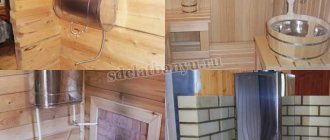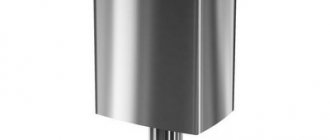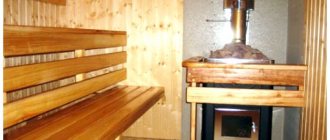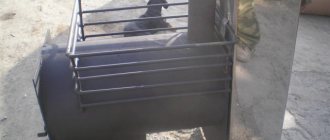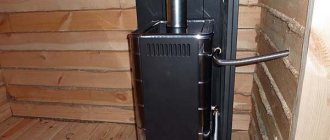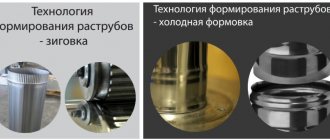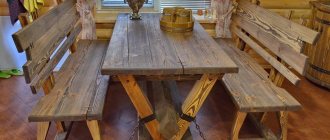How to install?
There are two main options for installing the system - connecting a structure with a supply of cold, contrast water or without an automation process.
In the first case, it is necessary to install a water supply system and create a water supply and locking device so that the bucket does not overfill. In the second example, installation will not cause any difficulties. You will need to install the bracket and bucket. If the dousing process is periodic, it is advisable to choose the 2nd method of attaching the system. After assembling a structure intended for water procedures, before use it is necessary to fill a full bucket of water and wait several hours for the wood to swell and block the connecting gaps. Also, a wooden container should be treated with a special varnish to ensure guaranteed protection against leaks and other external factors.
How to choose a dousing bucket for a bath, see below.
Tank on a pipe for a bath: types, principle of operation, dimensions and installation
Hello, dear guest!
Sit back and forget about your pressing problems for a moment. The topic of today’s article is one of the favorite vacation spots of Russian people. A place where people have long washed themselves, treated illnesses, met with friends, and simply hid for a while from life’s hardships.
Have you already guessed what I mean? Right! Today we will talk about the Russian bathhouse. About a classic bathhouse, but made in modern solutions, comfortable and safe. We will take a detailed look at the tank on a bath pipe, find out why it is needed, in which cases this option for heating water is optimal, and find out the dangers of choosing the wrong bath containers.
Why do you need a tank on a pipe?
Strong hot steam, invigorating tart aroma of wood, birch and juniper brooms, the special spirit of a Russian bath... Not a single sauna with scalding air can replace real light steam! Even in our time, a bathhouse is a favorite place to relax for a person tired of the everyday hustle and bustle. And no entertainment and shopping centers will replace it.
And now I’ll add a little horror to the beautiful picture.
Imagine - you have decided to build or renovate a bathhouse. And so, the walls are covered with new lining, fresh brooms are waiting for hot steam, and the simplest thing remains - to buy a tank for the sauna stove. It would seem, what could be simpler?
Modern stores are overflowing with bath accessories and there are a great variety of containers for heating water. Most are tanks for sauna stoves of various shapes, shiny, smooth to the touch, with high-quality and beautiful welds. It would seem, what else is needed?
Now let's take a closer look at the material of manufacture.
note
In 80% of cases it is stainless steel with the incomprehensible name AISI430. And few people know that the stainless steel in this AISI is only a shiny surface and a little chrome. And a sheet of such material burns out under the influence of direct fire in 3-4 months. It’s no wonder that the manufacturer’s warranty for such tanks is no more than 3 months. Moreover, the sheet thickness is rarely more than one and a half millimeters.
And this is where the fun begins. Imagine, you bought a tank for 10, 15, or even 30 thousand rubles and happily installed it on the stove in the bathhouse. And six months later a hole burned in the bottom. Scary?
So I'm scared.
But there is a great way to avoid all such troubles, even using products made from Chinese stainless steel. And one of them is installing a water tank directly on the sauna pipe.
The principle of operation of a tank on a pipe
The first Russian baths were heated “black”; smoke filled the room, leaving traces of soot and soot on the walls. This technology has long been a thing of the past; modern stoves are equipped with chimneys.
Vapors and gases leaving the stove through the chimney heat it up greatly. And this temperature can be used to heat water.
To do this, a tank is installed on the pipe. It encircles the pipe and the water in it is heated by hot gases. This solves two problems at once - heating water and thermal insulation of pipes.
Pros and cons of this design
The main advantages of installing a sauna tank on a pipe:
- The reservoir can be placed along the entire length of the pipe, which allows you to obtain a large volume of hot water. At the same time, increasing the volume of the container will not affect the heating time;
- The temperature of the gases in the pipe is high (up to 500 degrees), so heating is carried out quickly and evenly;
- Installing the tank is easy to do with your own hands;
- Hot smoke is not just discharged into the street, but heats the water, so the efficiency of the stove increases;
- The service life of the chimney increases;
- The water maintains its temperature for a long time while the pipe cools;
- No additional heating elements are required;
- The samovar tank can be installed not in the steam room itself, but at the attic level. In this case, hoses are connected to the heat exchanger to input cold water and output hot water.
Design disadvantages:
- Large tanks are difficult to install due to weight. If it is necessary to install a large container, it is necessary to use a fastening system, and the load should not fall on the stove, but on the walls or foundation;
- The water temperature cannot be controlled;
- The liquid boils away faster;
- The design is not suitable for every chimney. For example, if the pipe in the bathhouse is brick or asbestos, you will have to choose another option;
- If the heat exchanger is located high, it is difficult to fill it with water.
Types of factory tanks and average prices
Factory tanks have different configurations. Main parameters:
- Type of material;
- Design;
The most common materials are galvanized, steel, stainless steel, less common are products made of cast iron.
The most popular factory shape is a rectangle and a cylinder with a circular cross-section.
Average cost of a rectangular tank with a volume of 50 liters:
- Steel - 1000 rubles;
- Galvanizing - 1500-2000 rubles;
- Stainless steel - from 3000 rubles.
How to choose?
To begin with, you need to decide where the tank will be located - directly above the pipe, or it will be a remote structure located in the attic.
Installing a container in the attic is convenient, but not always possible - it all depends on the design of the roof and the possibility of supplying and discharging water.
Calculating the volume
The required volume of liquid is calculated from the norm of 15-20 liters per person plus 10-15 liters in reserve. For example, if a family of 2 people periodically washes in a bathhouse, then a tank of 50 liters will be enough. A family of 4 people will need a capacity of 80-100 liters.
Type of material
Pros and cons of steel, cast iron, stainless steel:
Cast iron containers are heavy, they are inconvenient to install, the water in them heats up slowly, but remains hot for a long time;
Containers made from it last longer than steel ones, but over time they rust and burn out;
Due to their high thermal conductivity, steel tanks heat up quickly and cool down just as quickly. The main advantage is the price, the main disadvantage is the low service life;
They combine all the advantages of iron products with high corrosion resistance.
Enameled products are found in stores. They are more durable than uncoated steel tanks, but are susceptible to chips, in place of which pockets of corrosion form.
How much does a bath font cost?
If we compare materials, the most expensive models are wooden, they are three times more expensive than plastic. A larch bowl per cubic meter costs approximately 45 TR, an oak bowl - 110 TR, a cedar bowl - 70 TR, a polypropylene bowl of the same size - 20 TR. By decorating plastic with wood, we get a big increase in price. If you do the installation and cladding yourself, it will be profitable and convenient.
It is difficult to propose a specific model. The production is so individual and unique that the cost can only be discussed as an average. If you choose a budget built-in plastic container, look at the “ElitePolymer” models, where the price tag starts from 20 tr.
The best traditional herbal barrels (single or double) are produced by RosKedr, starting at a price tag of 35 thousand rubles. Glued varnish at a convenient price can be found at BentWood, where the price tag starts from 27 thousand rubles.
How to install a hot water tank in a washing room?
So, how to properly install a tank in a bathhouse? If the water in the washing room comes from a tap, under pressure, you need a closed water supply system. The most ideal option for this is considered to be a stove with a coil inside, and a tank will be connected to it. However, the following method can be implemented: the tank will be suspended on the stove itself.
A properly connected sauna tank will look like this in a sauna: the water in the register heats up and rises into the tank, where it gradually cools down and soon drops down into the register. This is how circulation occurs, and in order to improve it somewhat, it is better to take water from the return line - although this is not very convenient, since in this case you will have to wait a long time until the tank heats up normally.
But you can use water as soon as the stove is heated. However, it is more thoughtful and effective if a full-fledged ability to switch water intake from direct to return is thought out - this is much more convenient. If the entrance and exit to the tank is made from below, then the circulation will be somewhat slower.
And the diagram of such a process itself will look like this:
- The tank is mounted in the steam room, precisely under the shelves, and is connected by pipes to the stove coil.
- In the tank, for stable circulation, the upper outlet is connected to the upper outlet of the coil, and the lower one is connected to the bottom. Hot water will be discharged from above, and cold water will be discharged from below.
- A safety and check valve is installed at the cold water inlet - it is also called a blast valve.
- The automatic firing pressure of the explosive is set.
This whole structure will work in this way: the filled tank will be heated through the coil, and when warm water is consumed, it will automatically be filled through the cold water supply. As the cold water heats up, if it is not used yet, this pressure will constantly increase, and when it reaches its critical point, an explosive will automatically go off, releasing all the pressure.
Finally, you should remember that the most important thing when installing and using the tank is to follow all the installation features described in the instructions for the tank. In addition, you need to adhere to safety measures when creating a tank yourself. If you follow the operating instructions, the sauna tank will serve you flawlessly and for a long time.
Bath water tank: purpose and advantages
As already mentioned, the container is used to heat water, which is subsequently used for bathing and various household needs: laundry, mopping, preparing a broom, etc.
The water in the tank increases the humidity in the room, which is especially useful and helps to avoid the problem of dry air.
Of course, today there is a huge selection of gas and electric water heaters, but sauna tanks do not lose their relevance. This is explained by their savings: when using a boiler, gas/electricity is wasted, but when the water is heated by a stove for a bath, then, in fact, there is no consumption at all, because in any case, in order to go take a steam bath, you need to heat the stove. Also, the tank will be indispensable if there is an accident on the gas main or power line, and the use of the water heater temporarily becomes impossible.
Sauna stoves equipped with a remote tank
One of the most convenient options for heating water is to install remote tanks. Such a tank can simultaneously cope with two tasks:
- supply of hot water to the washing compartment of the bathhouse;
- provision of hot water to sinks located in other rooms.
The great advantage of the installed remote tank is that its presence permanently eliminates such an unpleasant situation when the firebox brings the water to a boil without having time to completely warm up the entire volume of the steam room, which results in the room being filled with clouds of moist steam.
In addition, a remote tank is the only correct solution for those who want to acquire not a Russian bathhouse, but a sauna, the air of which must be extremely dry.
Typically, a remote tank made of stainless steel should be installed in a room located next to the steam room. Heating of the water poured into it is ensured using a heat exchanger mounted in a sauna stove and connected to the tank using pipes.
To circulate water without the use of pumps, the bottom of the tank must rise above the heat exchanger, sometimes called a register, by half a meter or a little more. To ensure that water circulation never occurs, it is necessary to:
- install connecting pipes not exceeding 3 m in length;
- for installation, choose pipes with a diameter of one inch or more;
- ensure that there is no sagging of the pipes and their slope is about 2-5°.
If one of the above conditions is not met, a pump may need to be installed.
Speaking about heat exchangers, it should be noted that for stoves of the “Zhara” brand, for example, they are given a cylindrical shape, and for their manufacture, stainless steel is used, the thickness of which is as much as 5 mm.
Easy-to-use and practical remote tanks, however, also have disadvantages, namely the complexity of their installation and connection. In addition, we should not forget about the significant costs associated with the purchase of rather expensive water heating registers-heat exchangers, pipes, taps, and connecting hoses.
The listed disadvantages of remote-type tanks are largely compensated by the convenient opportunity to equip a shower or connect a battery to the tank that can heat a locker room or shower in the winter cold.
How to choose a tank for a bath
The wide selection of different heating equipment has had little impact on the demand for conventional wooden tanks. Such products are environmentally friendly, light in weight, and have a wonderful aroma of wood, which makes the atmosphere in the steam room special. An additional advantage of such a capacity is resource saving, since the use of electricity or gas requires some costs. The constant presence of liquid in the room increases air humidity, which has a positive effect on the local microclimate.
It is especially important when purchasing a container to correctly calculate its volume. To do this, it is worth considering that each person spends on average about 25 liters of water per visit. Thus, for the needs of two people, a tank of 50 liters will be required. If you plan to go to the sauna with a large group, then it is better to equip the steam room with a spacious 100-liter tank.
Bath tank Source dekoriko.ru
Notes from experienced bath attendants
Those who constantly encounter bath products know all their best sides and problems. These little things are not talked about on the manufacturers’ websites, but they are useful for those who are planning to purchase a hot tub. Here are some subtleties from the professionals.
- The most convenient height option is 1.2 m.
- Ensure that the tank is in a vertical position. Provide it with steps, benches, and handrails. Eliminate slippery surfaces (place mats, towels).
- The most reliable tree is larch. This can even be installed outdoors. Next in terms of biostability are oak, cedar, and pine.
- If you choose one with a stove, look for one with an internal one, it is more efficient. Stainless steel with a thickness of at least 2 mm is guaranteed not to burn out or rust.
- A new wooden barrel may leak when first filled, this is normal. Within a day, the wood will swell and the flow will stop. If this does not happen, change the product, this is a defect.
- The wooden font must be constantly filled with water, which must be changed periodically. The water must be clean and fresh. Polypropylene models are absolutely unpretentious in everyday life.
- Do not place a wooden tank near heating sources, as this may cause the wood to dry out.
- Proper care of a wooden tank:
- cleaning with non-abrasive detergents;
- prevent water from freezing (outside);
- protect from direct sunlight;
- tighten the nuts on the hoops in a timely manner, preventing leakage (check once a month);
- Don’t forget to change the water, be sure to drain it to avoid the appearance of green mold.
9. It is practical, convenient, and useful to have a drain hole into the sewer, as well as a filter for water purification. Other bells and whistles can be added or not.
By the way! Having studied the materials, handy owners can build a font themselves. This applies to concrete street, metal, polypropylene (inside or outside the sauna) options. If you are not a carpenter, you can buy a wooden barrel in a store, and do the rest yourself. You will need skills in constructing a pit, the ability to lay concrete, lay tiles, and connect electrical and gas equipment.
Why do you need a font for a bath-sauna if there are snowdrifts in winter and a lake in summer? It is safer than natural sources, the water is cleaner, has a controlled temperature, and frees you from long distances in negligee to the reservoir and back. But in general, a bathhouse without a font cannot be considered a real Russian bathhouse, giving health, mood, and pleasure. Choose, use and improve your health with pleasure.
Methods for installing a water tank
Having decided on the type and material of manufacture, you can consider the available methods of installing devices that provide fast and efficient heating of water.
You can install a hot water tank with your own hands in the firebox, above the heater and next to the stove.
Installation in the combustion chamber
The method involves the use of a sauna stove with a large combustion chamber for internal installation of a water tank.
The following requirements are imposed on the device for heating water: minimum wall thickness - 0.8 mm, resistance to temperature changes and deformation.
The structure is heated over an open fire, so it can capture its base and end elements. This method is often recommended for installing stainless steel tanks.
Installation above the heater
An equally popular option, which involves installing a heater above the compartment for heating bath stones and generating steam.
If a cast iron device is used, it must be suspended from the ceiling structure using a metal cable and hooks. The best option is a lightweight stainless steel tank.
It is economical to install a water heater above the stove around the chimney pipe, which can provide accelerated heating of water from the stones and pipe.
Installation near the stove
This method involves installing the tank near heating equipment. As a rule, it is used in saunas with high air temperatures and low humidity.
In this case, the hot water tank is mounted at a distance of at least 250 cm from the direct heat source, and the water is heated using a double-circuit heat exchanger with cold water supply and hot water output.
Cold water is supplied to the heat exchanger and heated, then discharged into the heater, after which the heating cycle is repeated.
Installing a tank in a brick oven
You need to install a water tank in a bathhouse in a brick oven during the process of laying it. This often happens on row 10, depending on the oven model. When laying out a row, it is necessary to leave an opening for the tank, a recess. The dimensions of such an opening depend on the size of the tank itself, the main thing is that they must exceed the dimensions of the tank by several mm. To compensate for all thermal expansions.
Below, a plumbing tap crashes into the tank. In this case, hot water will be drawn directly from the bathhouse. Or it is possible to cut in a pipe, connect a pipe, and thus drain water into the washing room.
When the furnace masonry reaches the upper boundaries of the tank, we lay 2 metal strips on it, which will allow you to safely cover the tank with bricks. Then we close the tank and follow the order of the oven.
Other methods of heating water
Important! The use of gas boilers requires strict adherence to safety regulations. Installation and operation of equipment with a power of more than 50 kW involves the mandatory receipt of additional technical conditions and permits. Electric water heaters are available in two types:
Electric water heaters are available in two types:
- Flow type with optimal performance of 2.5 l/s. The equipment heats the water as it moves, consuming the greatest amount of electricity.
- Capacitive water heaters with an optimal volume of 100 l. They consume significantly less electricity. The water is heated for 3-4 hours, after which its temperature is maintained constant.
In order to save energy and ensure the ability to use the shower in the washing room at any time, a combined system is used. It consists of a furnace and an electric water heater, which can work simultaneously to quickly heat a large volume of water or separately, depending on the current need.
Even today, the bathhouse has not lost its relevance: the purpose of building a bathhouse or purchasing ready-made structures is the desire to improve one’s health in the most accessible and enjoyable way.
When installing a bath these days, stoves with a remote tank have gained particular popularity.
Peculiarities
A modern shower bucket for a bath is not much different from previous models, which were actively used by our grandfathers and great-grandfathers when they expressed a desire to improve their health. Essentially, this simple device is called a “shifter.” In order to increase comfort, buckets were and continue to be made with a rope and chain. Such a device is installed mainly in a specially designated place for dousing - in the washing room, next to the steam room. Why is such a remarkable device found in many village baths if there is no lake, river or pond in the immediate vicinity? A useful activity - dousing with cold water contains many benefits for the soul and body:
- the immune system is strengthened;
- blood circulation functions accelerate;
- skin color improves;
- the skin becomes firm and elastic;
- toxins are removed from the body;
- rejuvenation processes are activated.
A seemingly simple procedure gives an amazing effect. In addition to the above advantages, a person receives a charge of vivacity, energy, and good mood for a long period. The main advantages of the cold water dousing device:
- simple production in a minimum amount of time;
- use without other aids;
- allocation of a minimum number of free square meters;
- saving money (for dousing there is no need to build a shower, swimming pool, font).
The simple design can be installed anywhere in the bathhouse where it is possible to organize a water supply, as well as drain dirty waste into a sewer canal. The dousing device consists of three key elements:
- classic bucket with hoops;
- rotation system;
- wooden brackets.
The assembled mechanism, attached to the wall, is a U-shaped structure, in the middle of which, above the center of gravity, there is a bucket on the axis with a hanging metal chain and a handle at the end. At a certain point, the bucket is filled with clean, cold water. A man stands under an upside-down bucket, pulls the chain towards himself and douses himself.
Most craftsmen and lovers of this useful procedure improve the design and ensure that after the dousing is completed, the water automatically flows back into the empty bucket. It's not difficult to improve a simple device.
What is the design
- The principle of operation is that from a large tank to a small one, cold water flows through the drive pipe, is heated in the small tank, which is called a heat exchanger, and returns through the outlet pipe to the main tank, already heated.
- If the drive and outlet pipes are positioned at the correct angle, then the water will successfully circulate by gravity thanks to natural physical laws. But in order to avoid the formation of air pockets in the system and ensure faster and more uniform heating of the water, the tank for the heat exchanger in the bathhouse is equipped with an electric pump for forced circulation of liquid in the system.
- The heat exchanger can be located directly next to the firebox itself, in which case it is installed at the stage of construction of the furnace inside the structure. Or it may have the so-called samovar operating principle, when a small tank is mounted around a metal chimney for a bathhouse directly next to the firebox.
- But regardless of the location of the tank, professionals prefer systems in which the liquid circulates freely, without additional pressure.
Materials
If a lover of water treatments decides to independently make a simple device for healing the soul and body, such a craftsman will need materials to create a bucket:
- 2 metal headbands 4-5 cm wide;
- boards of wood species - larch, cedar, linden, oak.
The tree species listed above have good resistance to the negative effects of water. They will not crack or dry out for a long time. You will also need first grade woodworking products with a thickness of at least 1 cm to assemble the bracket. In order to increase the service life of a wooden bucket and improve its tightness, many lovers of cold, contrast showers install a special plastic liner inside. If you use an ordinary plastic bucket, such a banal attribute will not add attractiveness to the dressing room, steam room, or washing room.
In general, there are a lot of useful devices for a bathhouse, in terms of configurations. They differ, first of all, in the design of the bracket, bucket, as well as its container, and the use of various materials - a chain, a durable cord, a functional handle.
Made of stainless steel
When assembling the entire system, stainless steel sheets are necessary to strengthen the bucket. Two rims, cut from such sheets 4-5 cm wide, are covered with pre-made wooden boards with a fixed bottom. Also, stainless steel is often used to create brackets, which increases the reliability of the entire structure. In addition, a stainless steel chain is used. It looks much more attractive than a durable cord. The simplest designs use ordinary galvanized steel buckets. If you need to quickly create a simple dousing system or don’t have time to get sophisticated in design, you can use just such a bucket, but the brackets are also made of stainless steel.
Made of wood
Buckets for dousing, made from wood, are the most beautiful and aesthetically pleasing. To make such a container, you must first create templates for the sides. Then you should cut the prepared parts according to the template and process them using a plane and sandpaper. It should be remembered that the boards for the sidewalls need to be given a slightly trapezoidal shape, that is, the end planes must be ground at an angle of 3 degrees in such a way that when assembled, you end up with a bucket. To form the bottom, you will need to make a 4 mm recess on each plank. Leave 4 cm from the bottom edge.
Next you should prepare the parts and cut out the cover for the bottom. Use a hammer to give the metal rim at the bottom of the tub a rounded shape. Drill holes for riveting at the ends at the joints. Attach the rim to the bucket. You can make the top rim in a similar way. It should be at a distance of 10-15 cm from the bottom rim. When the tub is ready, the sharp edges must be cleaned with sandpaper.
What materials are used
The sauna tank is made of metal, but the specific material is selected taking into account financial capabilities, volume and heating characteristics. The most popular designs are:
- Cast iron. Main advantages: high strength, durability, while the water temperature remains for a long time after the furnace has stopped firing. At the same time, the cast iron container warms up slowly, and most importantly, it has a large mass, which requires reliable support when installing the structure.
- Steel. The cheapest and most accessible material used in economical structures. The water in a steel tank heats up quickly, but also cools quickly after the fire stops. The most important disadvantage is corrosion destruction, which requires protective covers. One of the common options for eliminating this drawback is the use of enamel tanks. However, when choosing this material, it should be taken into account that with local damage to the enamel, accelerated corrosion begins at the source of damage.
- Stainless steel. A tank on a pipe for a stainless steel bath is considered the most common design, because... optimally combines cost and durability. The material is more expensive than ordinary steel, but is not subject to corrosion and has a long service life. At the same time, stainless steel can be welded, and you can make a tank from it yourself.
The remote design of the tank is in more gentle conditions. Extreme temperatures (400-500 degrees) only affect the heat exchanger located on the chimney. The walls of the tank itself do not heat above 70-80 degrees, which means it can be made from different materials. In addition, it is usually placed on the wall, where the risk of damage is reduced. In such conditions, decorated enamel containers become very popular. Supply pipes for a remote tank in a bathhouse can be made of metal, composite material and heat-resistant plastic
It is important to ensure their thermal insulation
Remote heat exchanger for a bath
The simplest and most affordable way to make a tank for a bath is the built-in version, when it is hung on the chimney. It’s not for nothing that such a system is called a samovar in everyday life, because it uses the same principle, i.e. heating the water with hot smoke rising through the inner pipe. Such a tank is installed during the construction of the stove or installed by dismantling a section of the chimney.
In the selected location, a pipe is mounted on brackets, so that the gap between the outer diameter of the chimney pipe and the inner body of the tank pipe provides the required volume. The base is welded at the bottom of the tank body, and all gaps are sealed with heat-resistant sealant. To drain water, an outlet with a tap is welded (Fig. 1). The upper part of the tank is closed with a lid.
Figure.1 Installation diagram of a bath tank
In principle, the tank body can be made in a rectangular shape for the required capacity. The wall thickness is selected taking into account the volume. To make a small tank with a volume of about 50-55 liters, you can use a metal sheet with a thickness of 0.9-1.2 mm, and for a container of more than 70-80 liters you will have to use metal with a thickness of at least 1.5 mm.
If there is a water supply to the bathhouse, then a remote system is more suitable. It is shown in Fig. 1. In this case, a coil is mounted on the chimney. The hot water exits towards the remote tank from above, and the coolant returns, respectively, from below. During installation, it is necessary to install the necessary shut-off equipment (valves, taps, taps).
When installing a tank in a bathhouse on a chimney pipe, you will need the following tools and equipment: a welding machine and electrodes with a diameter of 2.5-3 mm, a grinder, a hacksaw, an electric drill, a hammer drill, a hammer, pliers, a set of keys, a caliper, a tape measure.
The sauna tank on the chimney pipe allows you to have a supply of hot water without unnecessary fuel consumption.
Such a system uses the energy of futile smoke, which gives a significant economic effect. A system of different designs can be made and installed with your own hands.
Keys to choosing a hot tub
If you want to install a contrast tank in your bathhouse, answer a few questions that the sellers will ask.
1. How many people should fit: a question of tank dimensions and volume. The font with a diameter of 1.5 m can accommodate 4-6 people. If there are two people washing and steaming, you will end up wasting water and electricity.
2. Where it will be installed: outdoor or indoor - they have different characteristics. If options are available, communications will be required. Outdoor ones can be dimensionless, internal ones - the area of the sauna is taken into account.
3. Installation option:
- free-standing, ready for use immediately;
- built-in is just a bowl that requires a deepening (pit), installation, cladding, but gives a chance for a creative approach.
4. Shape: round, oval, corner, rectangular. Non-standard is possible - in the style of modern design. A vertical (standing or sitting) compact barrel will look awkward on the lawn of a spacious area. A large oval one, taking up half the space, will also not please you, complicating the bathing process.
5. Material: here consider quality, usefulness, price tag, durability (you may not need it for a hundred years, inexpensive enough for a short time).
- wood: warm, environmentally friendly, healing effect;
- plastic: does not rot, does not collapse, you can choose shapes, sizes, easy to clean;
- composite: ideal for outdoor use, super durable.
6. Bowl coating:
- without coating: a special smell, wood substances dissolve in water, making it medicinal. Require special care. Not recommended for outdoor use.
- waterproof coating: easy to care for the container, no wood smell and no healing effect, strong due to glued rivets. Installation is possible even in an apartment.
7. Rim mount:
- hoops with a screw connection: fine adjustment, the ability to tighten to ensure tightness, used on traditional glueless models;
- rivets: fixed tension, suitable for varnished products, plastic.
8. Water heating, frequency of use:
if used frequently, it is better to use an electric heater; high degrees are not required here. a wood heater indoors will require smoke venting, possibly remodeling
Pay attention - built-in or attached oven (each option has its own advantages and disadvantages). Outside, a live fire and the pleasant warmth of the stove create additional relaxation and relaxation.
a gas heater is the most economical, but not every bathhouse has the conditions for safe installation. These questions need to be thought through in advance.
9. Additional equipment:
- aero-hydromassage systems;
- thermal insulation;
- water filtration and disinfection systems;
- different types of water heaters;
- backlight;
- touch control.
These points are not the most important when making an initial decision, but it is better to take them into account in advance. Over time, there will be a desire to improve something, to retrofit it, but everything is installed in such a way that you can’t get under it.
Selecting the optimal tank volume
An equally important task is to determine the appropriate tank volume. The calculation of this parameter should be carried out taking into account the rate of water consumption per adult for bathing procedures, which ranges from 18 to 26 liters of water.
For a family of 2 people, it is enough to purchase a 50-liter tank, for a holiday with a group of 4 to 6 people - a 100-liter tank.
Factory models of water heating devices are presented in a wide range of volumes - from 20 to 200 liters. Electric boilers also have different volumes - from 30 to 100 liters.
Mounting tanks used with sauna stoves
The name of such tanks is due to the method of their installation, since they are placed directly on top of the firebox. It is quite clear that mounting tanks can be purchased in specialized stores, but often craftsmen make them with their own hands, using the materials at their disposal: a piece of thick pipe, sheets of metal, etc.
When making such a tank on your own, special attention during the work and installation process should be paid to the strength of the seams and the tightness of the tank
The bottom of the tanks may be uneven or have a recess to ensure its secure installation on the firebox. You can also either purchase such models or make them yourself.
Heat exchanger on pipe
Heat exchanger for pipe
The temperature of the gas leaving the sauna stove is quite high, so it is advisable to use it. Accordingly, the heat exchangers, which will be discussed further, are attached only to the single-wall metal pipe of the furnace.
Heat exchangers for chimneys are also called samovar. The water in them heats up evenly and quickly enough, circulation occurs very quickly, and fuel savings are achieved. Additionally, such heat exchangers are a kind of fuses that prevent any leakage of smoke from the chimney into the room.
The heat exchanger and pipe are joined using heat-resistant sealant (up to 1000 degrees) and clamps. The pipes are connected using the technology discussed above.
Connecting the heat exchanger on the pipe
It is not necessary to make such a heat exchanger yourself; the cost of factory-made products is presented in table form.
Technical characteristics and prices of heat exchangers
Chimney diameter 105 mm Chimney diameter 115 mm Chimney diameter 130 mm Price, rub. 279028905290
| Volume, l | 8 | 8 | 20 |
| Steel | Stainless steel – 0.5 mm on the sides and 0.8 mm on the bottom/top | Stainless steel 0.5 and 0.8 mm | Stainless steel 0.5 and 0.8 mm |
| Weight, kg | 2,5 | 2,5 | 4,5 |
| Height, mm | 500 | 600 | 665 |
| Fittings | 3/4″ x 2 | 3/4″ x 2 | 3/4″ x 2 |
Fonts are different
A small container with hot or cool water, into which one plunges after a sauna or steam bath, can be of any type and size, it depends on capabilities and preferences. The ideal shape is round or round-vertical.
Why round is better:
- there are no corners, the water has a single temperature;
- contact with the container is minimal, most of the skin participates in heat exchange.
Oval and rectangular containers are quite suitable. For small baths, a corner tank will be convenient. The average volume is about ten cubic meters of water.
The appearance of the containers varies, it depends on the design, height-width, materials. It can be designed for two or three; there are double models, concrete barrels, and micro-pools. Material - from wood to concrete, it depends on imagination and price tag. Most modifications can be used in a country house, in a cottage (private house), in a yard, and even in an apartment.
Advantages and disadvantages of samovar systems
A sauna tank on a pipe is called a samovar. It is an integral part of the chimney pipe elbow. Its location is very convenient, the water heating process occurs much faster and more uniformly than with other locations. The design itself is very compact.
The negative aspects of samovar systems include the fact that filling the tank with water is not very convenient. But this issue is easily resolved if the top of the tank is in the attic and a water tap is connected to it.
Important. It is very dangerous to make mistakes in designing the volume of the container, since you can end up with very frequent boiling of water.
The material for making samovar containers is usually stainless steel. The possibility of corrosion over time when using other materials is detrimental to the normal operation of the bathhouse, therefore the decision to install a stainless steel container is the right decision.
Among other things, the high thermal conductivity of stainless steel guarantees fairly rapid heating of the water in the samovar tank, and the strength of this material allows you not to be afraid of deformation of the device due to temperature changes.
Wall-mounted tanks for sauna stoves
The convenience of stoves designed for the use of hanging tanks is that water heating tanks can be easily installed and also easily removed. As a rule, their suspension is provided using loops and hooks. Like all other water tanks, they are made of stainless steel. They include hatches for filling with water and taps that ensure the use of already heated water.
The Vravra range of stoves includes several products designed for the installation of wall-mounted tanks.
A significant drawback of such designs is that those steaming can get burned on their hot walls, and it is impossible to arrange a shower when using such tanks. In addition, heated water can boil in them, causing abundant formation of steam in the steam room that is not yet fully heated. True, the last problem can be solved in the following two ways:
- hanging the tank a little later;
- Periodically draining the hot water and refilling the tank with cold water.
The convenience of wall-mounted tanks is that they are ideal for retrofitting existing furnaces. They are convenient in small spaces and in combination with small stoves. They, like the mounted tanks, are easy to rinse and clear of accumulated scale.
An excellent system developed by specialists. Their tank can be used both as a mounted or remote one, but subject to the purchase of a water heating register and the installation of a water supply circuit.
Metal
Since water is hot, metal remains the best material for tanks. In addition to metal, wood and plastic are also used. These materials can only be used if they do not come into contact with objects heated above 90 degrees. Basically, the heating of water in the bathhouse is provided by metal tanks.
Here are the main types of such tanks:
- Installed on the chimney;
- Suspended (wall-mounted boiler form factor);
- Built into a sauna stove;
- Built into gas and other boilers;
- Remote for installation on a flat surface, floor and tabletop, as well as suspended.
The choice of a specific option is carried out according to the internal conditions of each bath. The power of the heat source, its type (stove or gas boiler), as well as the required amount of hot water are taken into account.
Another feature is how exactly the hot water in the bath will be used. Will it be a simple hot water tap or showers that require pressure. We will consider each option in more detail.
For metal tanks, there are several options for their design:
- Galvanized steel, painted with heat-resistant paint (not common);
- Enameled steel (the main type of tanks for baths, boilers, kitchen heaters);
- Thick-walled galvanized steel without paint (developed following the example of galvanized buckets and utensils);
- Cast iron enameled (very reliable, but rare);
- Stainless (the best type of tanks).
The most affordable ones are enamel tanks. They are mass produced. They are specially made for heating hot water. For little money you can find options for any capacity and configuration.
